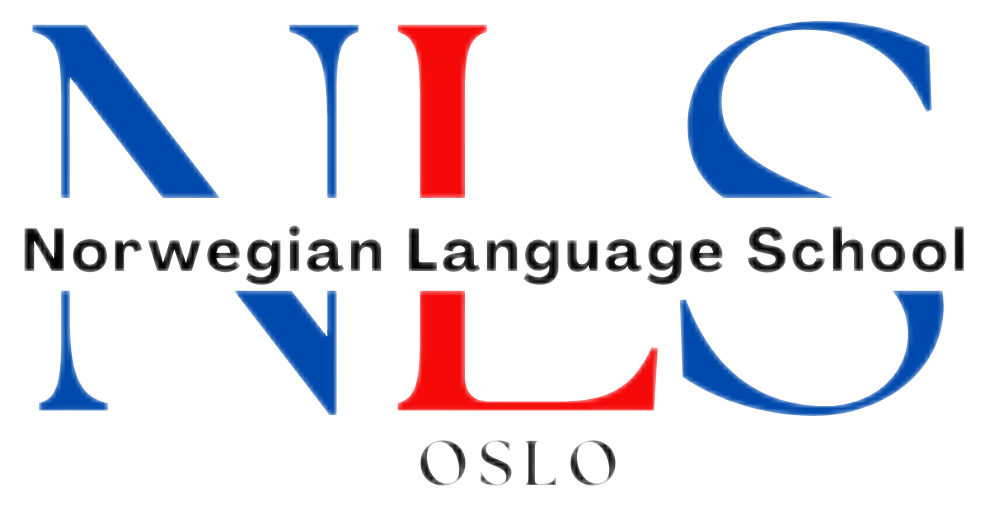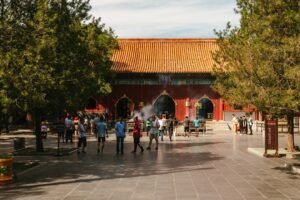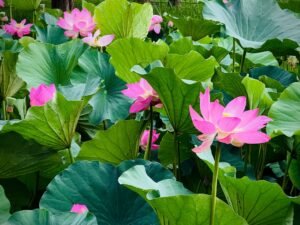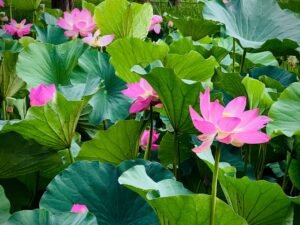

The Silent Dance of the Brush: Unlocking the Ancient Art of Chinese Calligraphy in Oslo
In the relentless hum of the 21st century, our hands fly across keyboards and our eyes dart across glowing screens. We communicate faster than ever before, yet we often feel a profound disconnect from the physical act of creation, from the quiet focus that has nourished human souls for millennia. There exists, however, an ancient discipline that serves as a powerful antidote to our modern malaise. It is a practice of profound stillness and dynamic energy, a meditation in motion, an art form that captures the very essence of the human spirit in strokes of ink on paper. This is the world of Chinese calligraphy, and a unique opportunity to learn its secrets awaits you in the heart of Oslo at NLS Norwegian Language School.
This is not merely an article about a course; it is an invitation to embark on a journey. We will delve into the deep philosophical currents that flow through this art form, trace its epic history through the rise and fall of dynasties, and uncover the alchemy of its sacred tools. We will explore how this silent dance of the brush can bring balance and clarity to a modern life. Finally, we will show you how NLS offers a personal atelier, a dedicated space for you to begin your own dialogue with this timeless tradition.
Table of Contents
TogglePart 1: The Philosophy of the Stroke – More Than Just Ink
To an uninitiated eye, Chinese calligraphy might appear as simply an aesthetic form of writing. But to truly understand it is to realize that each character, each stroke, is a universe of meaning, shaped by centuries of philosophical thought. The practice is an active expression of principles from Taoism, Confucianism, and Zen Buddhism.
The influence of Taoism is perhaps the most profound. The Taoist concept of wu wei (無為), often translated as “effortless action,” is the ultimate goal of the calligrapher. It is a state where the artist transcends conscious effort, allowing the brush to move with a natural, unforced grace, as if guided by the flow of the universe itself. The calligrapher doesn’t just draw a line; they become the line. The energy of the body, the qi (氣) or life force, is channeled from the dantian (the body’s energy center) through the arm and wrist, finally flowing out through the tip of the brush. A masterful stroke is thus a visible manifestation of balanced qi, a perfect harmony between intention and spontaneity.
From Confucianism, calligraphy inherits the values of discipline, balance, and self-cultivation. The rigorous training required to master the basic strokes instills patience and perseverance. The structure of each character, with its rules of balance and order, reflects the Confucian ideal of a well-ordered society and a morally upright individual. In ancient China, a person’s handwriting was considered a direct reflection of their character. Sloppy, unbalanced calligraphy was thought to signify a disorderly mind and a lack of moral discipline. Practicing calligraphy was therefore a way to cultivate one’s inner character, striving for the same harmony and integrity in oneself as in the characters one created.
Finally, the practice resonates deeply with Zen Buddhism, particularly in its emphasis on mindfulness and living in the present moment. The entire ritual of calligraphy—the careful grinding of the ink, the loading of the brush, the focused breathing before the first touch of paper—is an exercise in mindfulness. There is no “undo” button in calligraphy. Once a stroke is made, it is permanent. This demands complete presence and commitment to each moment, forcing the artist to let go of past mistakes and future anxieties, and to be fully engaged in the here and now. The empty space on the paper is just as important as the ink, representing the Zen concept of mu (無), the void from which all things arise.
Part 2: Echoes of Dynasties – A Narrative History
The story of calligraphy is the story of China itself. Its evolution mirrors the nation’s technological advancements, political shifts, and cultural transformations. The journey begins over 3,000 years ago in the Shang Dynasty with Oracle Bone Script (甲骨文, jiǎgǔwén). These were not works of art but divinatory records, etched with sharp tools into bone and shell. The characters were raw, pictographic, and angular—the primal scream of a written language being born.
As society progressed into the Zhou Dynasty, writing found a new home on ritual bronze vessels. This Bronze Script (金文, jīnwén) was more refined, its lines thicker and more deliberate, reflecting the permanence and solemnity of the objects they adorned. But it was the unification of China under the first Emperor, Qin Shi Huang, that catalyzed the first great standardization. The resulting Seal Script (篆書, zhuanshu), particularly the “small seal script,” was a marvel of elegant, geometric precision. With its uniform thickness and intricate, curving lines, it was a script that symbolized imperial power and order. However, it was slow and impractical for the needs of a burgeoning bureaucracy.
The demands of administration in the Han Dynasty gave rise to a revolutionary new style: Clerical Script (隸書, lishu). The complex curves of Seal Script were simplified into more angular, faster strokes. A characteristic “wavy” quality emerged, with certain horizontal strokes flaring out at the end, like a “silkworm head and a wild goose tail.” This was a pivotal moment. Calligraphy was no longer just about ritual or imperial decree; it was becoming a more efficient tool for communication and, in turn, a medium for personal artistic expression.
This newfound freedom ushered in the golden age of calligraphy. From the foundations of Clerical Script, the “big three” modern styles emerged. Regular Script (楷書, kaishu) became the new standard, a perfectly balanced and legible style that remains the benchmark for printed text today. It is the epitome of structural perfection. For speed and flow, scholars developed Running Script (行書, xíngshū), a semi-cursive style that connects strokes in a fluid, graceful dance. It is the style of the personal letter, the scholar’s notes, carrying both clarity and personality. At the furthest end of the spectrum lies Cursive Script (草書, caoshu), the “grass script.” This is calligraphy unbound—an abstract, explosive expression of emotion where entire characters are reduced to a single, continuous flourish of ink. It is the ECG of a poet’s heart, utterly illegible to the untrained but breathtaking in its raw energy.
This era produced the art form’s undisputed master, Wang Xizhi (王羲之), the “Sage of Calligraphy.” His masterpiece, the Preface to the Poems Collected from the Orchid Pavilion (蘭亭集序, Lántíngjí Xù), composed during a drunken poetry gathering in 353 AD, is considered the apex of Running Script. The original was so prized that it was eventually buried with the Tang Emperor Taizong. All that remains are meticulous copies, yet even these copies radiate a spontaneity and sublime grace that has inspired calligraphers for nearly 1,700 years.
Part 3: The Alchemist’s Tools – The Four Treasures of the Study
In calligraphy, the tools are not mere implements; they are revered partners in the creative process, known collectively as the Four Treasures of the Study (文房四寶, wénfáng sìbǎo). Each treasure has a rich history and is the product of sophisticated craftsmanship.
- The Brush (筆, bǐ): A Chinese calligraphy brush is a marvel of organic engineering. Unlike Western brushes, it has a fine, tapering point surrounded by a fuller belly of hairs, allowing for an astonishing range of expression—from a razor-thin line to a broad, powerful swath—all within a single stroke. The hairs can come from various animals—goat for softness and absorbency, wolf (weasel) for springiness and resilience, or a combination of the two to create a perfectly balanced tool. The handle, often made of bamboo, is an extension of the artist’s arm.
- The Ink (墨, mò): Traditional ink is not a liquid from a bottle but a solid inkstick. It is created by collecting the fine soot from burning pine resin or tung oil, which is then mixed with an animal-glue binder and pressed into ornate molds. The calligrapher prepares the ink by grinding the stick with a small amount of water on an inkstone. This process is a slow, circular meditation, a ritual to quiet the mind before the act of creation begins. The artist has complete control over the ink’s consistency, from a deep, velvety black to watery, translucent greys.
- The Paper (紙, zhǐ): The soulmate of the brush and ink is Xuan paper (宣紙, xuānzhǐ). Often mistranslated as “rice paper,” it is actually made from the bark of the blue sandalwood tree and rice straw. Its magic lies in its absorbency and strength. It receives the ink with a unique sensitivity, allowing for subtle bleeding effects and capturing the energy of every nuance of the brushstroke, from its speed to the pressure applied.
- The Inkstone (硯, yàn): The humble inkstone is the foundation upon which the liquid ink is brought to life. Carved from fine-grained slate or stone, a high-quality inkstone has a surface that is fine enough to gently abrade the inkstick into microscopic particles, yet smooth enough not to damage the delicate hairs of the brush. They are durable objects of art in themselves, often passed down through generations.
Part 4: Your Atelier in Oslo – Personalized Calligraphy Studies at NLS
Understanding the philosophy and history of calligraphy is one thing; feeling the brush in your own hand is another entirely. NLS Norwegian Language School offers you the rare opportunity to move from appreciation to practice, providing a personal atelier in the heart of Oslo for your artistic journey.
This is not a conventional classroom environment. The instruction at NLS is strictly one-on-one, ensuring a learning experience that is as unique as your own handwriting. This bespoke mentorship allows your experienced tutor to focus entirely on your progress, adapting each lesson to your specific needs, pace, and interests. Whether you are a complete novice taking your first tentative strokes or someone looking to refine your technique in a specific script, the curriculum is built around you.
Imagine your first lesson. You will be introduced to the Four Treasures not as abstract concepts, but as tangible tools. You will learn the meditative ritual of grinding the ink, feeling the solid stick transform into a fragrant, liquid pool. Your tutor will guide you in holding the brush correctly—vertically, with a relaxed yet firm grip, engaging your whole arm, not just your fingers. You will practice the fundamental strokes—the eternal dot, the resolute horizontal, the sweeping vertical—which are the building blocks of every single Chinese character.
With personalized guidance, you will explore the different scripts, perhaps starting with the foundational stability of Regular Script (Kaishu) to build a strong technical base. As you gain confidence, you might move on to the fluid elegance of Running Script (Xingshu), learning to link strokes and imbue your characters with rhythm and life. The flexible scheduling at NLS means these sessions can be seamlessly integrated into your life, providing a consistent sanctuary of calm and focus amidst your weekly routine.
This is more than a course; it is an apprenticeship. It is a dedicated time and space to disconnect from the digital noise and reconnect with yourself through a practice that is both intellectually stimulating and profoundly calming.
Take the first step on this rewarding path. Explore the personalized calligraphy courses at NLS Norwegian Language School and book your first session. Discover your personal calligraphy journey here
Part 5: The Enduring Relevance of the Silent Dance
In an age of artificial intelligence and virtual reality, one might ask: what is the relevance of grinding ink by hand to draw ancient symbols on paper? The answer is: more than ever. Chinese calligraphy is not about clinging to the past; it is about reclaiming essential human experiences that are becoming increasingly scarce.
It is a powerful form of digital detox. The intense focus required silences the endless chatter of notifications and social media, drawing you into a state of “flow” where time seems to fade away. It is a practice of mindfulness that trains your attention and cultivates inner peace. The physical benefits are also significant, improving fine motor control, posture, and breathing.
But perhaps most importantly, it is a path to authentic self-expression. In a world of curated online personas, calligraphy offers a raw and honest reflection of your inner state. Your joy, your calm, your frustration, your energy—it all finds a voice through the dance of the brush. It teaches you to embrace imperfection, to see beauty in a spontaneous splash of ink, and to understand that the journey of creation is as valuable as the final product.
The silent dance of the brush matters today because it reminds us what it means to be human: to create, to focus, to find harmony between mind and body, and to leave a mark that is uniquely and beautifully our own.
Do not let this profound experience remain a mystery. The guidance and expertise you need to begin are waiting for you. Learn more and enroll in your one-on-one course today
Your journey into the quiet, beautiful world of Chinese calligraphy is just one decision away. It is a journey that promises not only a new skill but a new way of seeing—the world, and yourself. Take that step.
If you want to learn Norwegian, you can register for classes here. We look forward to hearing from you and helping you become fluent in Norwegian.





